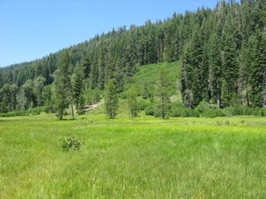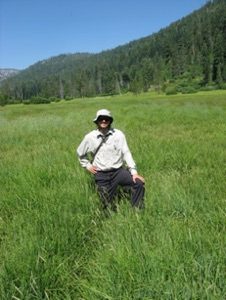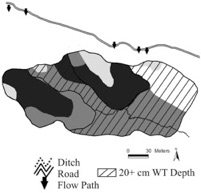Drakesbad is the largest natural meadow in Lassen Volcanic National Park. It is supported by ground water discharging from volcanic layers on Flatiron Ridge adjacent to the meadow (Left photo below show shrub vegetation on hillslope at one spring). The site was homesteaded more than 100 years ago and used for domestic livestock feeding during the summer. The site vegetation was altered by the removal of willows and the construction of drainage ditches. When the area was incorporated into LVNP the NPS built a water supply system including a large tank to store spring water, and a road to access the tank. This road also impacted Drakesbad by intercepting water flowing from the springs toward the meadow. Graduate student Lindsay Patterson and I worked with Lassen staff, and NPS water resources division wetland program lead Joel Wagner to perform the needed site analyses to identify impacts to the meadow and to design and implement a pilot project in 2006. Lindsay’s main work for her thesis was instrumental in leading this analysis and restoration implementation, and was published (Patterson, L. and D. J. Cooper. 2007. The use of hydrologic and ecological indicators for the restoration of drainage ditches and water diversions in a mountain fen, Cascade Range, California. Wetlands 27:290-304. The paper can be downloaded using the link below). An EIS has been completed on the management of the Warner Valley, allowing restoration to proceed. Below center, Evan Wolf stands in one of the existing ditches with his right leg. These ditches will be filled, and the meadow hydrologic regime, which is a sheet flow system originating on the hillslope to be recreated. Figure below right shows the meadow, with the water tank road at the top, and levels of hydrologic impact from the road and ditches.


